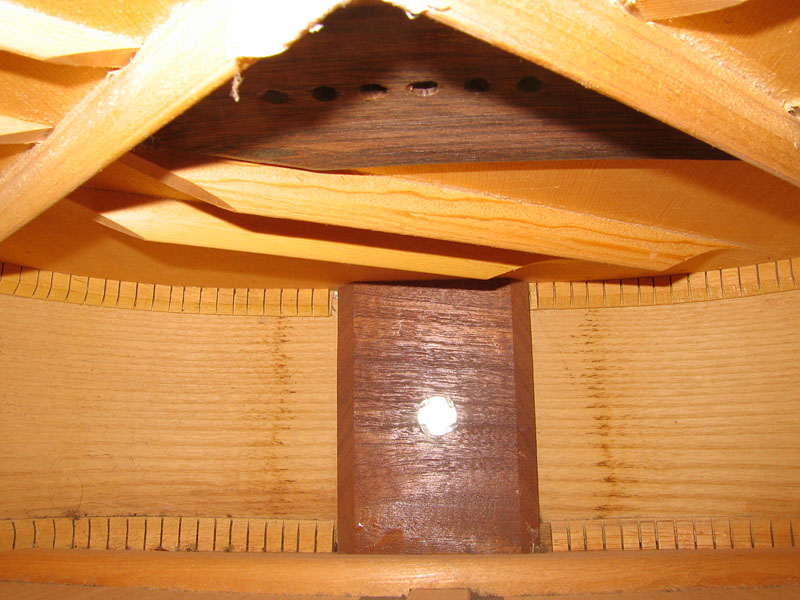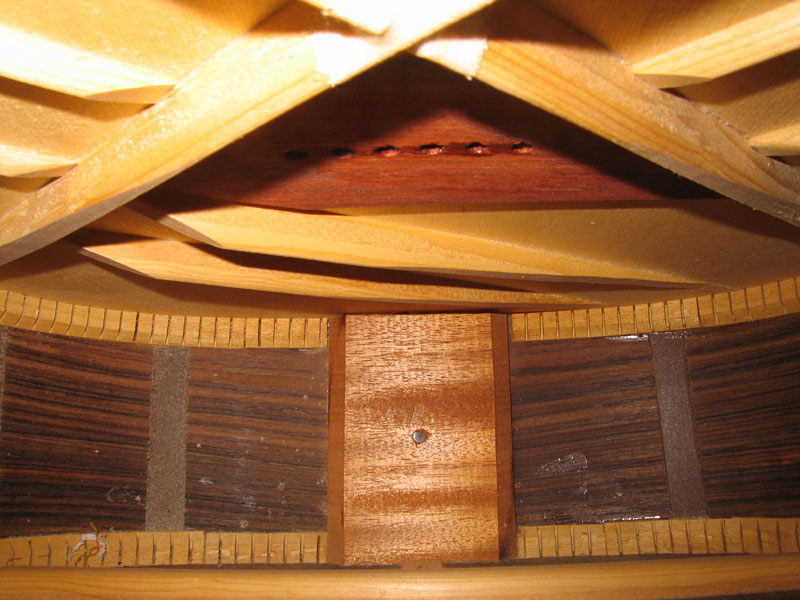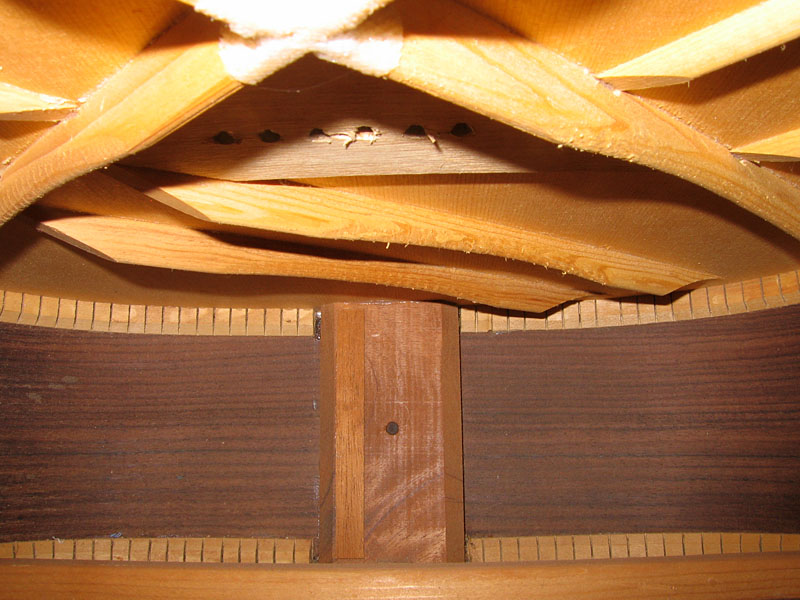GardMan
Enlightened Member
I purchased my first Guild, a 1972 D-35, in January 1973 ( a story that I have retold several times on LTG, and will save retelling again for another day). Sometime around 1986, I purchased a second D-35 (from 1978), for Anne. I immediately noticed that the two guitars, tho the same model built just 6 years apart, differed significantly in weight: the 1978 D-35 (subsequently weighed in at ~5.5 lbs) was notably heavier than my 72, which is my lightest Guild, at just 4# 4oz...
Altho my interest was piqued, investigation of the weight difference lanquished for more than 20 years. Then, in the summer of 2006, two "life changing" events happened: (1) I found "Lets Talk Guild, " and (2) I bought two more Guilds dreads from eBay auctions: a 74 G-37 Bld with arched maple back (top dated Apr 1974) , and a 74 D-25M with arched mahogany back (top dated Aug 1974). Built just a few months apart in 1974, I initially thought I would audition them, choose the one I liked, and resell the second. Little did I know that these two guitars would set me out on a quest to experience the different tone woods Guild used on its line of dreadnaughts, leading eventually to a 71 D-44 (pear wood), 76 D-50, 81 D-46, 92 D-55, 94 DV-72 NT (turquoise) 94 DV-72MK (malachite), and 95 DV-73 (turquoise, coral, onyx, nickel silver).
As I accumulated my small collection of Guild dreads, I again noticed the difference in weights: the two dreads from 71 and 72 were markedly lighter than those made later in the 70s, and into the 80s and 90s. This time, However, I started poking around, first with my fingers, feeling around inside the sound hole and the neck block, and then looking around inside with an automotive inspection mirror. I fairly quickly discovered that Guild changed the bracing of the upper bout on its dread models sometime in the middle of 1974, guitars built prior to the change included a "popsicle brace" between the transverse brace and the neck block. In contrast, all those built later have a neck block extension that reaches (or comes close to) the transverse brace, flanked by two thin "wing braces:" see figure... (sorry for the links... apparently there are different "rules" for posting images in blogs)
The top dates on my 74 G-37 (which has a popsicle brace) and my D-25M (which has the neck block extension and wing braces) pinpoint the date of the change to between April and August 1974. As new guitars came in, I would look inside and see how they were braced... and fellow LTGers added observations from their own dreads, all of which are consistent with the bracing change occurring in mid-1974.
As part of my NGD ritual (as I change strings and set up each new guitar), I use an inspection mirror to look inside at the top braces flanking the sound hole, knowing that Guild often stamped the top completion date on one of these braces (the practice of stamping dates inside the top stopped sometime in the 80s). Imagine my surprise in Feb 2007, when I looked inside my newly arrived 1992 D-55 and saw a large plate surrounding the sound hole, instead of individual braces flanking each side of the sound hole. For several years, I considered that this new bracing pattern might be specific to the D-55 model, until I found the same pattern in a 1994 DV-72MK that I purchased in fall 2014. After a little research, and comments from a number of LTGers, it appears that the sound hole reinforcement plate was a bracing feature in a number of dreadnaught and jumbo models from ~1984-1994 (it has been documented in models including the D-15, D-55, D-65S, DV-72, JV-72, and a DV-73 from 1994). According to fellow LTGer West R Lee, Hans Moust suggested that the sound hole plate was introduced to reinforce the rosette region of the soundboard during this period, when soundboards might have been thinner. Guild apparently returned to individual braces flanking the sound hole sometime at the turn of 94-95... My DV-73 (neck block date in Jan 1995) was individual braces flanking the sound hole. see figure...
Altho my primary on-line guitar hangout is "Lets Talk Guild," I have also spent a considerable amount of time over on the "Unofficial Martin Guitar Forum," where I have learned a lot about guitar construction reading the technical threads. I particularly found the Martin bracing library interesting. One of the techniques that intrigued me, sometimes referred to as a "Henkogram"(for the UMGF member who advocated the technique), uses lights placed inside the guitar body to image the placement of the top braces thru the guitar's top. The braces show as shadows in the image. I filed the technique away, planning to try it out with my Guild dreadnaughts during some future string change. That was a couple years back...
Well, I finally got around to experimenting with Henkograms during my "semi-annual mass Guild string change extravaganza" in December 2015... I used 6-9 battery operated undercounter LED puck lights (from the local Lowes) placed in the body of each guitar (the guitars were on a stand, and the lights were balanced somewhat precariously on the back braces), a cardboard and black felt cover over the sound hole, and my digital camera on a tripod. Exposures ranged from 3 to 15 seconds for the images shown. The D-35 was my first attempt... too much ambient light made the flare on the treble side, and I only had 6 lights, leaving the neck block area somewhat underexposed. I went and bought another pack of 3 lights (3 for $10), and used 8-9 lights for the other images. Here are the results obtained with my five remaining Guilds: see figure...
Individual detailed images of each of my current stable of Guild dreads can be found here... (click on any thumbnail for an enlarged view).
You can see the changes in upper bout bracing, from the "popsicle" brace of my 72 D-35 to the wing braces of all subsequent builds, and the shadow of the "soundhole re-inforcement plate" in my 1994 DV-72MK, compared to the separate braces surrounding the sound holes in all of the other dreads. My 1992 D-55 also had a sound hole plate, as does my newest addition, another DV-72 (turquoise this time) from February 1994... observations from other LTGers suggest this bracing pattern was in use between ~1984 and 1994.
It,s also apparent that the positions of the lower bout braces and tone bars vary a bit... it's hard to tell if this variation from guitar to guitar, model specific, or year specific. But, at first glance, it appears as if the '76 D-50 and '81 D-46 bracing patterns are quite similar, while those on my three DVs (which are nearly identical to each other) are somewhat more similar to that of the '72 D-35. Is the the "vintage" bracing pattern represented in the model numbers? So, here's the revised sketch (also linked above) of the Guild bracing patterns I have observed (the tone bar differences in different guitars with pattern 2 aren't really shown)...
This last image shows diagrams specifically comparing the bracing in my two '94 DV-72s (neck block dates from Feb and Apr 1994) and my '95 DV-73 (neck block date from Jan 1995). A question that has been asked more than once on LTG... "What is the difference between the DV-72 and DV-73?" Based on my observations, I would conclude that if the two DVs were built in the same year, West R Lee's answer, quoting/paraphrasing Hans Moust: "Inlay!" is correct. However, given that most DV-72s were built in 1993 and 1994, and thus incorporate the sound hole reinforcement plate, while most DV-73s were built in 1995 and have two thin braces flanking the sound hole, one might argue that most DV-73s are braced differently from most DV-72s...
I'll conclude by saying that I have only sampled a small number of Guild dreads from a just one Guild factory (Westerly, RI). I'd love to hear of any variations observed in other models or individual instruments. For example, Hans Moust has mentioned that Guild experimented with a modified "fan" bracing on some D-40s at some point (in the 60s?)... I'd love to see a Henkogram showing that bracing pattern!
Thanks to everyone that stuck fingers, mirrors, or cameras into their Guilds for me!
Dave Gard 26 January 2016
Altho my interest was piqued, investigation of the weight difference lanquished for more than 20 years. Then, in the summer of 2006, two "life changing" events happened: (1) I found "Lets Talk Guild, " and (2) I bought two more Guilds dreads from eBay auctions: a 74 G-37 Bld with arched maple back (top dated Apr 1974) , and a 74 D-25M with arched mahogany back (top dated Aug 1974). Built just a few months apart in 1974, I initially thought I would audition them, choose the one I liked, and resell the second. Little did I know that these two guitars would set me out on a quest to experience the different tone woods Guild used on its line of dreadnaughts, leading eventually to a 71 D-44 (pear wood), 76 D-50, 81 D-46, 92 D-55, 94 DV-72 NT (turquoise) 94 DV-72MK (malachite), and 95 DV-73 (turquoise, coral, onyx, nickel silver).
As I accumulated my small collection of Guild dreads, I again noticed the difference in weights: the two dreads from 71 and 72 were markedly lighter than those made later in the 70s, and into the 80s and 90s. This time, However, I started poking around, first with my fingers, feeling around inside the sound hole and the neck block, and then looking around inside with an automotive inspection mirror. I fairly quickly discovered that Guild changed the bracing of the upper bout on its dread models sometime in the middle of 1974, guitars built prior to the change included a "popsicle brace" between the transverse brace and the neck block. In contrast, all those built later have a neck block extension that reaches (or comes close to) the transverse brace, flanked by two thin "wing braces:" see figure... (sorry for the links... apparently there are different "rules" for posting images in blogs)
The top dates on my 74 G-37 (which has a popsicle brace) and my D-25M (which has the neck block extension and wing braces) pinpoint the date of the change to between April and August 1974. As new guitars came in, I would look inside and see how they were braced... and fellow LTGers added observations from their own dreads, all of which are consistent with the bracing change occurring in mid-1974.
As part of my NGD ritual (as I change strings and set up each new guitar), I use an inspection mirror to look inside at the top braces flanking the sound hole, knowing that Guild often stamped the top completion date on one of these braces (the practice of stamping dates inside the top stopped sometime in the 80s). Imagine my surprise in Feb 2007, when I looked inside my newly arrived 1992 D-55 and saw a large plate surrounding the sound hole, instead of individual braces flanking each side of the sound hole. For several years, I considered that this new bracing pattern might be specific to the D-55 model, until I found the same pattern in a 1994 DV-72MK that I purchased in fall 2014. After a little research, and comments from a number of LTGers, it appears that the sound hole reinforcement plate was a bracing feature in a number of dreadnaught and jumbo models from ~1984-1994 (it has been documented in models including the D-15, D-55, D-65S, DV-72, JV-72, and a DV-73 from 1994). According to fellow LTGer West R Lee, Hans Moust suggested that the sound hole plate was introduced to reinforce the rosette region of the soundboard during this period, when soundboards might have been thinner. Guild apparently returned to individual braces flanking the sound hole sometime at the turn of 94-95... My DV-73 (neck block date in Jan 1995) was individual braces flanking the sound hole. see figure...
Altho my primary on-line guitar hangout is "Lets Talk Guild," I have also spent a considerable amount of time over on the "Unofficial Martin Guitar Forum," where I have learned a lot about guitar construction reading the technical threads. I particularly found the Martin bracing library interesting. One of the techniques that intrigued me, sometimes referred to as a "Henkogram"(for the UMGF member who advocated the technique), uses lights placed inside the guitar body to image the placement of the top braces thru the guitar's top. The braces show as shadows in the image. I filed the technique away, planning to try it out with my Guild dreadnaughts during some future string change. That was a couple years back...
Well, I finally got around to experimenting with Henkograms during my "semi-annual mass Guild string change extravaganza" in December 2015... I used 6-9 battery operated undercounter LED puck lights (from the local Lowes) placed in the body of each guitar (the guitars were on a stand, and the lights were balanced somewhat precariously on the back braces), a cardboard and black felt cover over the sound hole, and my digital camera on a tripod. Exposures ranged from 3 to 15 seconds for the images shown. The D-35 was my first attempt... too much ambient light made the flare on the treble side, and I only had 6 lights, leaving the neck block area somewhat underexposed. I went and bought another pack of 3 lights (3 for $10), and used 8-9 lights for the other images. Here are the results obtained with my five remaining Guilds: see figure...
Individual detailed images of each of my current stable of Guild dreads can be found here... (click on any thumbnail for an enlarged view).
You can see the changes in upper bout bracing, from the "popsicle" brace of my 72 D-35 to the wing braces of all subsequent builds, and the shadow of the "soundhole re-inforcement plate" in my 1994 DV-72MK, compared to the separate braces surrounding the sound holes in all of the other dreads. My 1992 D-55 also had a sound hole plate, as does my newest addition, another DV-72 (turquoise this time) from February 1994... observations from other LTGers suggest this bracing pattern was in use between ~1984 and 1994.
It,s also apparent that the positions of the lower bout braces and tone bars vary a bit... it's hard to tell if this variation from guitar to guitar, model specific, or year specific. But, at first glance, it appears as if the '76 D-50 and '81 D-46 bracing patterns are quite similar, while those on my three DVs (which are nearly identical to each other) are somewhat more similar to that of the '72 D-35. Is the the "vintage" bracing pattern represented in the model numbers? So, here's the revised sketch (also linked above) of the Guild bracing patterns I have observed (the tone bar differences in different guitars with pattern 2 aren't really shown)...
This last image shows diagrams specifically comparing the bracing in my two '94 DV-72s (neck block dates from Feb and Apr 1994) and my '95 DV-73 (neck block date from Jan 1995). A question that has been asked more than once on LTG... "What is the difference between the DV-72 and DV-73?" Based on my observations, I would conclude that if the two DVs were built in the same year, West R Lee's answer, quoting/paraphrasing Hans Moust: "Inlay!" is correct. However, given that most DV-72s were built in 1993 and 1994, and thus incorporate the sound hole reinforcement plate, while most DV-73s were built in 1995 and have two thin braces flanking the sound hole, one might argue that most DV-73s are braced differently from most DV-72s...
I'll conclude by saying that I have only sampled a small number of Guild dreads from a just one Guild factory (Westerly, RI). I'd love to hear of any variations observed in other models or individual instruments. For example, Hans Moust has mentioned that Guild experimented with a modified "fan" bracing on some D-40s at some point (in the 60s?)... I'd love to see a Henkogram showing that bracing pattern!
Thanks to everyone that stuck fingers, mirrors, or cameras into their Guilds for me!
Dave Gard 26 January 2016


